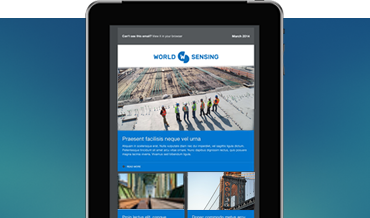The unseen risks of ageing infrastructure: A call for resilience
In the context of the ongoing expansion and evolution of modern infrastructure, the implementation of structural health monitoring has attained paramount importance, especially when much of this vital infrastructure is ageing and failing to match the pace of modern demands, including environmental challenges. Infrastructure monitoring plays a vital role in safeguarding against potential hazards, detecting structural impairments, and instituting preventive alert mechanisms.
The looming threat of ageing infrastructure
With each passing year, the strain of ageing civil infrastructure, such as bridges or dams, becomes more apparent, revealing a landscape of potential hazards that lurk beneath the surface of our daily lives. The framework that was built to support growth 70 or 50 years ago now teeters on the edge of obsolescence, ill-equipped to carry the demands of modern society.
With each passing year, the strain of ageing civil infrastructure, such as bridges or dams, becomes more apparent, revealing a landscape of potential hazards that lurk beneath the surface of our daily lives. The framework that was built to support growth 70 or 50 years ago now teeters on the edge of obsolescence, ill-equipped to carry the demands of modern society.
The issue at hand is twofold:
Firstly, the architectural and engineering achievements of the past were designed with a different era in mind and could not possibly foresee the exponential population growth, the impact of climate change, and the resultant pressures on infrastructure. This mismatch between design intent and current requirements puts the structural integrity of these infrastructures at risk, heightening the probability of collapse and the consequences of casualties that might result.
Secondly, this challenge is combined with the slow transition towards technology and digital operations. In numerous cases, ageing infrastructures suffer from a deficiency in maintenance practices, but even in those cases where maintenance efforts are undertaken, there is lack of awareness of the potential benefits of digitalising monitoring programmes.
Overall this reluctance to use digital solutions hampers proactive maintenance and predictive analytics, making it challenging to detect and address potential issues before they escalate.
Embracing innovation for resilient infrastructure
The journey towards strengthening infrastructure against time is becoming possible thanks to different parameters that can revolutionise how infrastructure is monitored, maintained, and managed.
- Remote monitoring technology
Connected devices, sensors, software, and systems, powered by the Internet of Things (IoT) and artificial intelligence (AI), offer a previously unimaginable capacity to monitor infrastructure health in real-time. These technologies allow for an accurate understanding of wear and tear, environmental impacts, and usage patterns, enabling a shift from the traditional, reactive model of infrastructure maintenance to one that is predictive and proactive.
Wireless remote monitoring not only elevates the precision and efficiency of activities but also significantly reduces risky on-site visits. Operators can move towards a more reliable, sustainable, and cost-effective model of infrastructure management, where interventions are timely, targeted, and informed by data.
In a recent case in Malaysia, worse was avoided during the unfortunate collapse of a bridge in the Johor state. Thirty-six wireless tiltmeters were deployed and connected to a data visualisation software sending an alert to the bridge operator while identifying movement. Thanks to real-time data and the reactivity of local authorities, the bridge was closed to the public and no casualties were reported.
Through the deployment of monitoring technologies, it becomes possible to identify potential risks and weaknesses long before they evolve into disasters.
- Local and global regulatory standards
The integration of connected and remote monitoring instruments is often led by new regulations implemented locally or globally. This proactive methodology contrasts with reactive models, even if actions are unfortunately often precipitated by failure, resulting in higher costs and increased risks to safety.
New regulations signal the will to move to a more enlightened approach, where the value of foresight, regular oversight, and strategic investment in infrastructure health is recognized as pivotal to the sustainability and safety of our communities.
Yet, regulation and legislation regarding infrastructure monitoring vary significantly depending on the country or regional area, leading to disparities in safety standards and maintenance protocols. In some areas where regulations are lax or enforcement is still weak, infrastructure monitoring may be inadequate, leading to neglect and deterioration over time.
To mitigate risks, there is a critical need for harmonised international standards and enhanced regulatory frameworks that ensure the safety and resilience of vital infrastructure systems for the benefit of all.
- Preventive infrastructure maintenance
Adopting an approach that prioritises real-time monitoring and preventive maintenance bypasses potential disasters and serves to protect public welfare, extending the service life of civil infrastructure. This also mitigates the financial weight associated with extensive repairs, highlighting the economic prudence of preventative measures. The consistent application of maintenance protocols acts as a crucial feedback mechanism, furnishing data, instrumental in guiding the development of future infrastructure projects.
New constructions can not only achieve a higher standard of durability but are also imbued with the flexibility and resilience required to withstand the tests of time and use.
Several months after the Genoa tragedy where the Morandi bridge collapsed, France initiated a procedure, called “Connected Bridges”, to collect data and evaluate the safety of France’s bridges. Released in late June 2019, with subsequent updates in 2022, the evaluation advocates for measures to enhance the management of these structures. Shortly thereafter, a strategy was introduced to optimise monitoring and execute necessary maintenance and repairs, along with rebuilding of unrepairable bridges.
In sum, it is crucial to switch to a proactive method when taking care of infrastructure. This means rethinking how we build resilient buildings emphasising the importance of preventing risks, setting up real-time monitoring and maintenance. This way, new standards are set for a future where infrastructure not only endures but can face the challenges of modern living.

